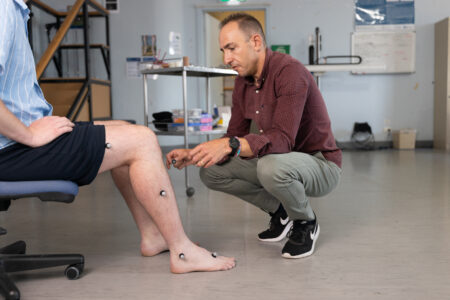
Dr Corey Joseph inherited a curiosity about the way things work from his father.
“Dad was a mechanic by trade, and his father was a builder. They were very handy people.”
By watching his father at work and asking him questions, Corey learned how complex machines work, and how to fix them.
Corey says these early experiences led him to become a biomechanist.

“There’s no formalised pathway to become a biomechanist,” explains Corey. “It’s really a research pathway. Essentially, you can either enter through Exercise Sciences or you can enter through Biomedical Sciences. Then you do an honours project and a PhD that specialises in some form of biomechanics.”
The field is niche enough that Corey often must explain to people what biomechanics means.
“In simple terms, ‘bio’ meaning a living thing, and mechanics, as in motion and the working parts of something. In other words, the mechanics of something that’s alive and moves.”

Corey works one day a week with the Victorian Paediatric Rehabilitation Service at the Monash Children’s Hospital, two days a week with the Refugee Health and Wellbeing team, and three days a week with the Clinical Gait Analysis Service (CGAS) at Kingston Centre – the oldest service of its kind in Australia.
“We see a diverse range of populations to look at how they walk and try to improve how they walk by making recommendations. If somebody doesn’t walk very well, you need to understand whether that’s a function of them having short muscles, or is it a function of something else? When they come into the lab, we measure their muscles to see how long it or short they are, how much impact spasticity there is, and then they come into the lab for the measurement of how they move.”
In the lab, the team uses a 3D motion capture system to see how patients walk.

“We place markers all over the person so we’re modelling the skeleton as they walk. If you’ve ever seen the making of movies like Avatar, that’s exactly what we do. It’s pretty cool.”
Once Corey processes that data, he sits down with the CGAS team – including a rehabilitation physician, an orthotist, and physiotherapists – to discuss what intervention might help the patient.
“That might be a medical intervention or a physical intervention, depending on the outcome we want for the person.”

Alongside his work with patients, Dr Joseph has a passion for research.
“The thing that I love is that the research we do matters. At Monash Health, if we’ve got a question we don’t know the answer to, whether that’s with the Refugee team or the CGAS team, we do research to try to improve the clinical service and patient outcomes, and that’s what I love. That’s what drives me.”
But Corey also highlights the rigours of research.
“I’ve got a paper that should be published soon in the clinical gait space. It’s a paper that I’ve been trying to publish for six years. It’s a ruthless process. You keep sending into journals and getting rejected. It’s been challenging, and I’m really proud the paper has been accepted.”


